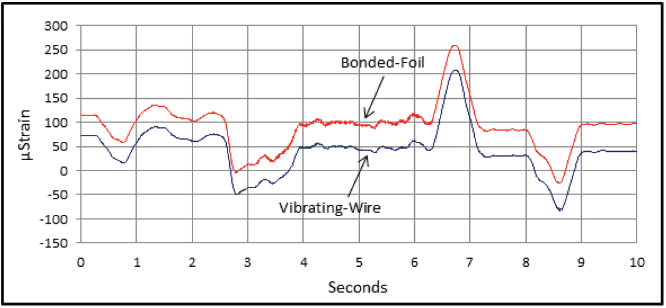Dynamic Vibrating Wire Performance
Campbell Scientific has developed vibrating wire (VW) interfaces that use the VSPECT® technology and provide dynamic measurements. This methodology has been tested with a wide variety of sensors from different VW sensor manufacturers to establish its interoperability. The sensors included strain gauges, crack meters, pressure transducers, and load cells. These experiments were conducted in a laboratory setting and in field deployments. In one experiment, shown in Figure 2, a tracking solar array was instrumented with VW and bonded-foil strain gauges at the indicated locations.

The panel of the array measures 13.7 m (45 ft) wide by 7.9 m (26 ft) tall, and it pivots atop a concrete and steel pedestal that is 6.1 m (20 ft) tall. When the array tilts and rotates, significant dynamic stresses are produced in the structure.
Figure 3 shows a representative 10-second time series of strain data measured by a VW gauge (blue) and a bonded-foil gauge (red) while the solar array was in motion. For visibility, an artificial offset was applied to the data.

As shown by Figure 3, the VW gauge (a GEOKON VK-4150) was measured at 100 Hz with the Campbell Scientific CDM-VW300 Dynamic Vibrating Wire Analyzer connected to the CR3000 Measurement and Control Datalogger. The bonded-foil gauge (an HBWF-35-250-6 from Hitec Products, Inc.) was also measured at 100 Hz using the CR3000. A comparison of the spectra of these two signals indicates that the frequency responses of both gauges were able to fully capture the spectral content of the motion of the structure. The performance of the VW analyzer typically matches or exceeds the performance of the resistive-foil gauges.
